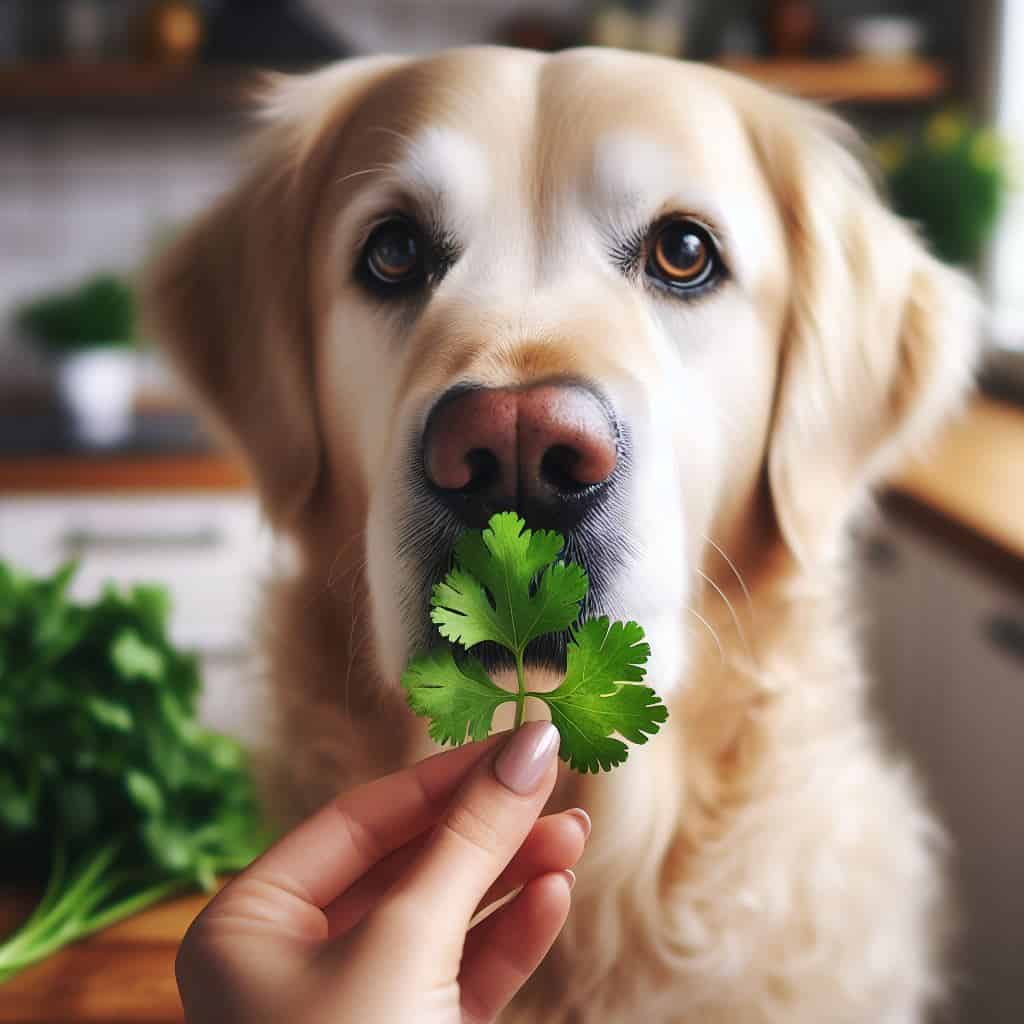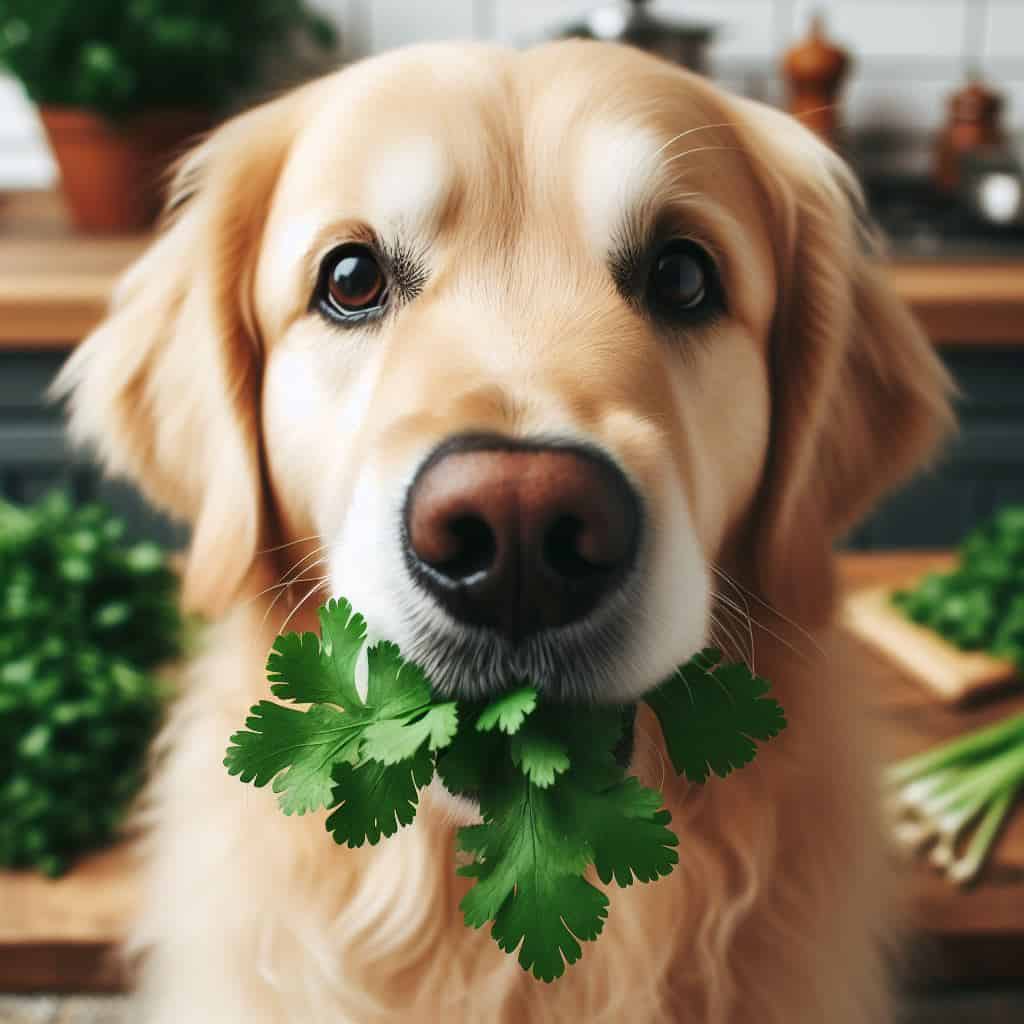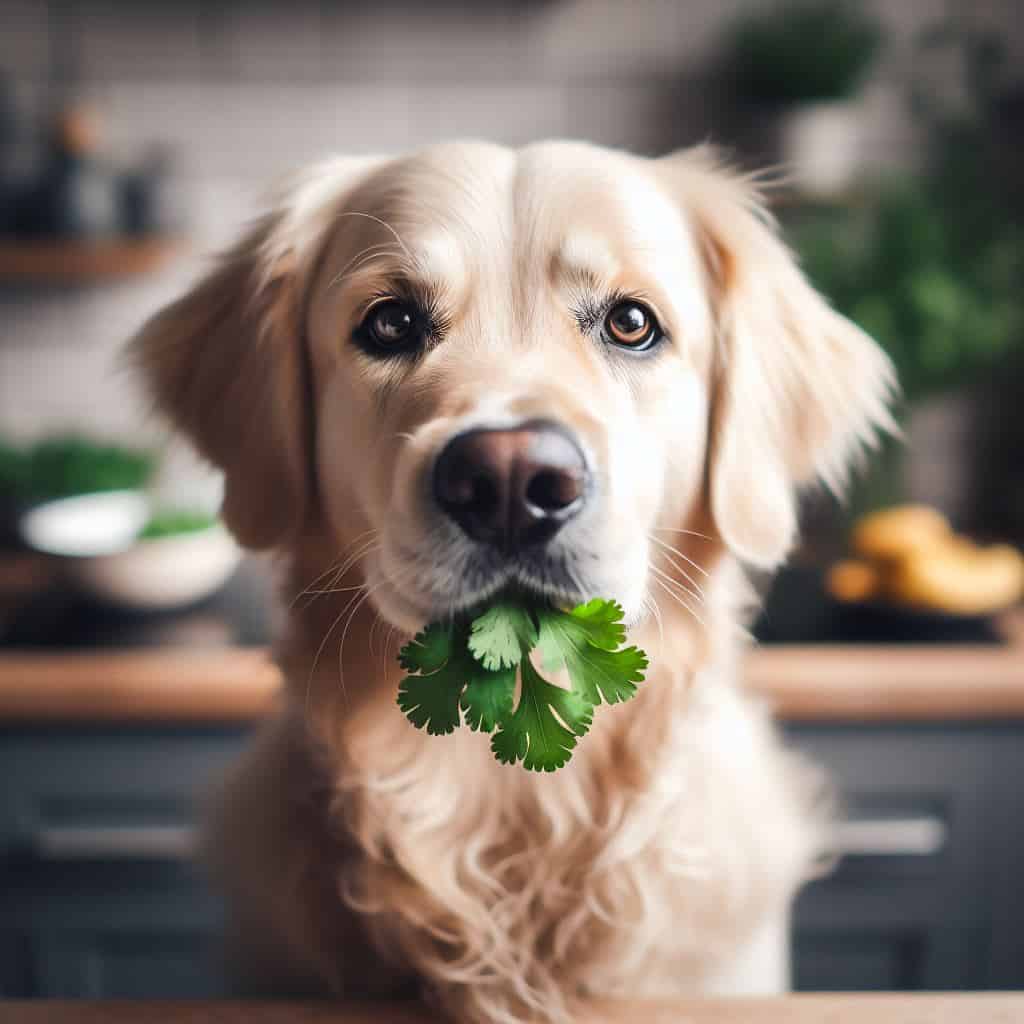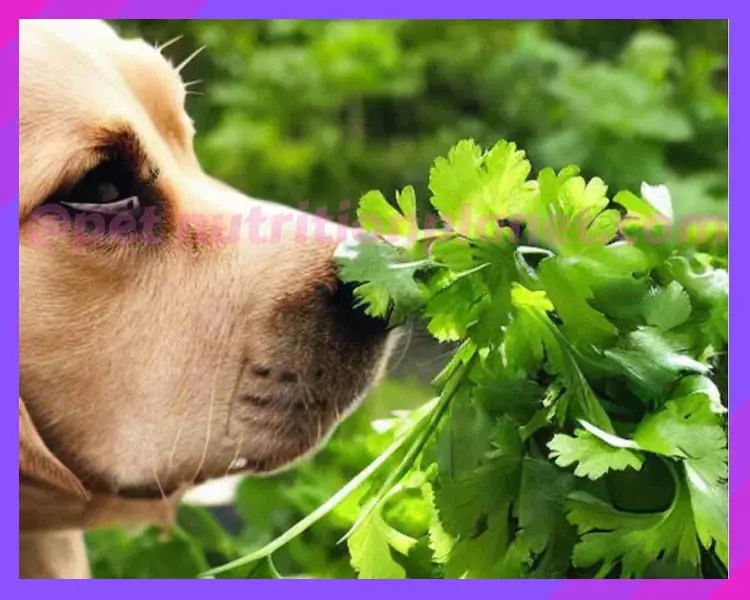Dogs are undoubtedly one of the most beloved pets worldwide, and as pet owners, we always strive to provide them with the best possible care.
One of the ways we can take care of our furry friends is by choosing their food carefully. While there are many human foods that dogs can eat safely, there are also some that can be harmful to their health.
Cilantro is a herb that has gained popularity in recent years for its nutritional benefits and unique flavor profile. However, as pet owners, it’s essential to know whether cilantro is safe for our furry companions.
This blog post aims to explore the question: Can dogs eat cilantro?
We will delve into various subtopics such as nutritional benefits of cilantro for dogs, potential risks and side effects associated with feeding your dog cilantro, safe serving sizes and preparation methods of cilantro for dogs, and finally, alternatives to cilantro for dogs.

What is cilantro ?
Cilantro is a herb that belongs to the parsley family. It is also known as coriander, Chinese parsley or dhania.
The plant has delicate green leaves that are used in various cuisines around the world, especially in Latin American and Asian dishes.
Cilantro has a distinctive aroma and flavor that can be described as citrusy, slightly peppery and earthy. Apart from its culinary uses, cilantro also has medicinal properties.

It contains antioxidants and essential oils that have anti-inflammatory and antibacterial properties. Cilantro can help to lower blood sugar levels, reduce cholesterol levels and improve digestion.
Despite its popularity in many cuisines, some people dislike cilantro due to its soapy taste. This aversion is believed to be genetic, with some people having a specific gene that makes them perceive cilantro differently.
Can Dogs Eat Cilantro ?
Dogs can eat cilantro! The good news is that cilantro is generally safe for dogs to eat in moderation. In fact, it can provide some health benefits for them as well.
Cilantro contains vitamins A, C, and K, which are essential for maintaining healthy skin, bones, and immune function.
It also has antioxidants that help fight off free radicals and reduce inflammation.
However, like with any food item, it’s important to be cautious when feeding cilantro to your dog. Some dogs may have allergies or sensitivities to certain herbs or spices, including cilantro.
If you notice any adverse reactions such as vomiting or diarrhea after giving your dog cilantro, it’s best to avoid giving it to them in the future.
Additionally, you should always wash fresh herbs thoroughly before giving them to your dog. This ensures that any harmful bacteria or pesticides are removed from the leaves.
It’s also worth noting that while cilantro itself may be safe for dogs to eat in small quantities, certain dishes that contain cilantro may not be suitable for them.
For example, if a dish contains garlic or onions along with cilantro (such as salsa), it could be harmful to your dog if consumed in large quantities.
However, as with all foods given to pets (and humans!), caution should always be exercised when introducing new items into their diet.

Health Benefits Of Cilantro For Dogs
1.Anti-inflammatory properties:
Cilantro contains antioxidants that help reduce inflammation in the body. This is especially beneficial for dogs with arthritis or other inflammatory conditions.
2. Digestive aid
Cilantro contains enzymes that aid in digestion and can help prevent digestive problems such as bloating and gas.
3. Freshens breath
Bad breath is a common problem among dogs, but cilantro can help freshen their breath naturally.
4. Immune system booster
Cilantro contains vitamins A and C, which are essential for maintaining a healthy immune system in dogs.
5. Natural flea repellent
The strong scent of cilantro is known to repel fleas and ticks naturally without the use of harsh chemicals.
6. Rich in nutrients
Cilantro contains several essential nutrients like calcium, potassium, iron, and magnesium that are important for maintaining good health in dogs.
7. Promotes healthy skin and coat
The antioxidants present in cilantro promote healthy skin by reducing inflammation that causes skin irritation or allergies. Additionally, it has antibacterial properties that prevent bacterial infections on the skin.
8. Detoxifies the liver
Cilantro is known to have detoxifying effects on the liver by removing heavy metals from the body, which can improve liver function in dogs.
9. Reduces anxiety
The calming properties of cilantro make it an excellent natural remedy for reducing anxiety levels in dogs who suffer from separation anxiety or noise phobia during thunderstorms or fireworks displays.
10. Helps regulate blood sugar levels
Studies have shown that cilantro may help regulate blood sugar levels by increasing insulin secretion from the pancreas, making it an excellent choice for diabetic dogs.
While these benefits are impressive, it’s important to note that like any food item given to your dog should be given after consulting with your vet to ensure they do not have any allergies or underlying medical conditions before feeding them new foods.

How much cilantro can dogs eat ?
Firstly, it’s important to note that cilantro is not toxic to dogs and can be included in their diet in moderation. However, excessive consumption of cilantro can lead to digestive upset and other health issues.
The recommended amount of cilantro for dogs varies based on their size and weight.
Generally speaking, small breeds should be given no more than 1 teaspoon of chopped fresh cilantro per day, while larger breeds can have up to 1 tablespoon.

It’s worth noting that some dogs may have an aversion to the taste or smell of cilantro. In such cases, forcing them to consume it may not be beneficial or enjoyable for them.
Side Effects of feeding excessive cilantro to dogs
While cilantro is generally safe for dogs to consume in small amounts, there are potential health risks associated with its consumption in excess quantities.
Excess cilantro can cause a range of side effects in dogs. Here are six of the most common:
1) Gastrointestinal problems: Cilantro contains oils that can irritate a dog’s digestive system. Eating too much cilantro can lead to vomiting, diarrhea, and stomach pain.
2) Allergic reactions: Some dogs may be allergic to cilantro. Symptoms of an allergic reaction include itching, swelling, hives, and difficulty breathing.
3) Liver damage: Cilantro contains compounds that have been shown to cause liver damage in some animals. If consumed in large quantities over time, excessive cilantro may lead to liver disease in dogs.
4) Increased heart rate: The oils found in cilantro can stimulate a dog’s nervous system and cause an increase in heart rate. This can be dangerous for dogs with underlying heart conditions.
5) Decreased appetite: Dogs who consume too much cilantro may lose their appetite or refuse to eat altogether.
6) Neurological problems: In rare cases, excessive consumption of cilantro has been linked to neurological problems such as seizures or tremors.
If you suspect your dog has consumed too much cilantro or is experiencing any of these symptoms after eating the herb, seek veterinary care immediately. Your veterinarian will likely recommend treatment based on the severity of your dog’s symptoms.
How to prepare cilantro for dogs?
Preparing cilantro for dogs can be a bit tricky, as not all dogs may like the taste or texture of the herb.
Step 1: Choose Fresh Cilantro
The first step in preparing cilantro for your furry friend is to choose fresh cilantro. Make sure that the leaves are bright green and free from any blemishes or signs of wilting. Also, ensure that there are no pests or insects on the leaves.
Step 2: Wash The Cilantro Thoroughly
After selecting fresh cilantro, it is essential to wash it thoroughly before serving it to your dog. Rinse the leaves under cold water and remove any dirt or debris that may be present.
Step 3: Chop The Cilantro
Once you have washed the cilantro thoroughly, chop it into small pieces using a sharp knife or kitchen scissors. This will help make it easier for your dog to eat and digest.
Step 4: Mix With Your Dog’s Food
Now that you have prepared the cilantro by washing and chopping it into small pieces, you can mix it with your dog’s food. You can either sprinkle chopped cilantro over their regular meal or mix it in with wet food.
Step 5: Serve As A Treat
If your dog enjoys eating fresh herbs as treats, you can serve them with whole sprigs of fresh cilantro as a healthy snack option. This is especially useful if your dog has bad breath because cilantro contains compounds that help neutralize odors in their mouth.

Tips to feed cilantro to dogs
1. Start Small
It’s important to introduce new foods slowly and gradually. Start by giving your dog a small amount of cilantro and observe how they react to it. If they show any signs of discomfort or digestive issues, stop feeding them immediately.
2. Wash the Cilantro
Before feeding cilantro to your dog, make sure you wash it thoroughly with water to remove any dirt or pesticides.
3. Use Fresh Cilantro
Always use fresh cilantro when feeding your dog as stale or expired herbs can cause digestive problems.
4. Chop It Up
Chop up the cilantro into small pieces before feeding it to your dog so that they can easily chew and digest it.
5. Mix It with Their Food
If your dog is hesitant about trying new foods, mix chopped cilantro with their regular food or treats.
6. Don’t Overdo It
While cilantro is safe for dogs in moderation, don’t overfeed them as too much can cause diarrhea or upset stomachs.
7. Use It As A Supplement
Cilantro can be used as a supplement in addition to their regular diet as it contains vitamins A and K, calcium, iron, potassium and magnesium which are all essential for good health.
8. Consult Your Vet First
It’s always best to consult with your veterinarian before introducing any new foods into your dog’s diet especially if they have any pre-existing medical conditions or allergies.
Best Ways To Incorporate Cilantro Into Dog’s Diet:
Cilantro is a popular herb used in many dishes, and it can be a great addition to your dog’s diet. However, it is important to ensure that you incorporate cilantro into your dog’s diet in a safe and healthy way.
One of the best ways to do this is by adding fresh cilantro leaves to your dog’s food. You can chop up the leaves and mix them into your dog’s regular meals, or you can use them as a garnish on top of their food.
Another way to incorporate cilantro into your dog’s diet is by making homemade treats that include the herb.

You can make homemade dog biscuits using cilantro as one of the ingredients or mix chopped cilantro with other herbs such as parsley, mint or basil for added flavor.
You may also consider adding fresh cilantro leaves to your dog’s water bowl. This will help enhance the taste of their water while providing them with extra nutrition.
However, before incorporating any new ingredient into your pet’s diet, always consult with a veterinarian first.
They will be able to tell you if there are any underlying health concerns that could be affected by consuming cilantro.
Can dogs eat raw ciliantro ?
While raw cilantro is safe for dogs to consume, feeding it raw requires some precautions.
Raw cilantro can contain harmful bacteria such as Salmonella or E.coli that can pose a significant risk to your dog’s health.
The first step in feeding raw cilantro to your dog is to make sure it is thoroughly washed.
Cilantro can harbor harmful bacteria and parasites, so it’s crucial to clean it properly before serving it to your pet.
Rinse the cilantro leaves under running water and pat them dry with a paper towel. Once the cilantro is clean, you can chop it into small pieces or blend it into a puree.
Adding cilantro to your dog’s food can help enhance its flavor while providing additional nutritional benefits.
You can mix chopped cilantro into your dog’s regular meals or add a spoonful of pureed cilantro on top of their food.

Another way to feed raw cilantro to your dog is by making homemade treats.
You can create tasty snacks by combining chopped cilantro with other pet-friendly ingredients like peanut butter or sweet potato puree. Mix the ingredients together until they form a dough-like consistency, then shape them into bite-sized balls or cutouts using cookie cutters.
Feeding raw cilantro to dogs requires proper cleaning and preparation techniques. Whether you choose to add chopped leaves or pureed form of this herb, always do so in moderation while keeping an eye on any adverse reactions from your pet.
In addition to serving sizes, the preparation method also matters when feeding cilantro to your dog.
Can Dogs Eat Cooked Cilantro?
Yes, dogs can eat cooked cilantro. Cooking cilantro can help eliminate any potential bacteria and make it easier for your dog’s digestive system to process.
You can add cooked cilantro leaves or stems in their food or mix them with other pet-friendly ingredients like boiled chicken, rice or sweet potatoes for a healthy treat.
Can Puppies Eat Cilantro?
No puppies should not eat cilantro. A balanced diet is crucial for their growth and development, but not all foods are safe for them to eat. One such food is cilantro, which puppies should not consume.
It can cause digestive problems in puppies if ingested. One of the primary reasons why puppies should avoid cilantro is because it contains high levels of essential oils that can irritate their stomach lining.

These oils can cause vomiting, diarrhea, and abdominal pain in puppies that may lead to dehydration or other health complications.
Moreover, cilantro also contains a compound called linalool that can be toxic to dogs in large quantities. It can cause liver damage and even lead to death if consumed in excessive amounts.
Therefore, as a responsible pet owner, it’s important to be mindful of what your puppy eats. Always consult your veterinarian before introducing any new food into your puppy’s diet.
Alternative Herbs Safe For Canine Consumption:
Although cilantro may not be toxic to dogs, some canines may experience digestive issues or allergic reactions when they consume this herb. Fortunately, there are several alternative herbs that are safe and beneficial for dogs.
One such herb is parsley, which is often used as a natural breath freshener for dogs. Parsley contains vitamins A and C as well as antioxidants that help promote healthy digestion and support the immune system.
Additionally, parsley has anti-inflammatory properties that can aid in reducing joint pain and swelling in older dogs.
Another safe herb for canine consumption is basil. Basil contains essential oils that have antibacterial properties and help fight against infections in dogs.
It also contains iron, calcium, and vitamins A and C which support healthy bones, teeth, skin, and eyesight.
Rosemary is another alternative herb that can add flavor to your dog’s diet while providing health benefits. Rosemary contains antioxidants that protect against free radicals which cause cell damage leading to cancer or other diseases.
Additionally, rosemary has anti-inflammatory properties that help reduce inflammation caused by arthritis or other conditions.
Lastly, thyme is another safe herb for canine consumption with antimicrobial properties effective against bacteria such as Salmonella or E.coli found in contaminated food products sometimes consumed by pets accidentally.
Final Verdict : Can Dogs Eat Cilantro?
In conclusion, dogs can eat cilantro in moderation and with proper preparation. As discussed in this blog post cilantro offers many nutritional benefits to our furry friends such as vitamins A and C, iron, and fiber.

However, it is important to note that some dogs may experience potential risks and side effects such as gastrointestinal upset or allergic reactions.
To ensure the safety of our pets when feeding them cilantro, it is crucial to follow safe serving sizes and preparation methods.
Although cilantro is generally safe for dogs when used properly, dog owners should always monitor their pets’ eating habits to ensure that they’re responding well to new foods.
Conclusion:Can Dogs Eat Cilantro ?
In conclusion, adding fresh herbs like cilantro into your dog’s diet can be a great way to provide them with additional vitamins and minerals.
We hope this blog post has answered any nutrition-related questions you had about whether dogs can eat cilantro or not!
Woof woof For Now 😉
XoXo
Genie
Related Links :
- American Kennel Club (AKC) – Nutrition Section: The AKC offers a comprehensive guide on dog nutrition, covering various topics from basic dietary needs to specific nutritional advice for different dog breeds. https://www.akc.org
- PetMD – Dog Nutrition Center: PetMD is a trusted source for pet health information, and their Dog Nutrition Center features articles on feeding tips, essential nutrients, and how to choose the right dog food. https://www.petmd.com
- The Association of American Feed Control Officials (AAFCO): While not a traditional article site, AAFCO sets standards for pet and animal feeds in the United States. Their resources can help you understand what nutritional labels mean and what standards dog foods should meet. https://www.aafco.org
